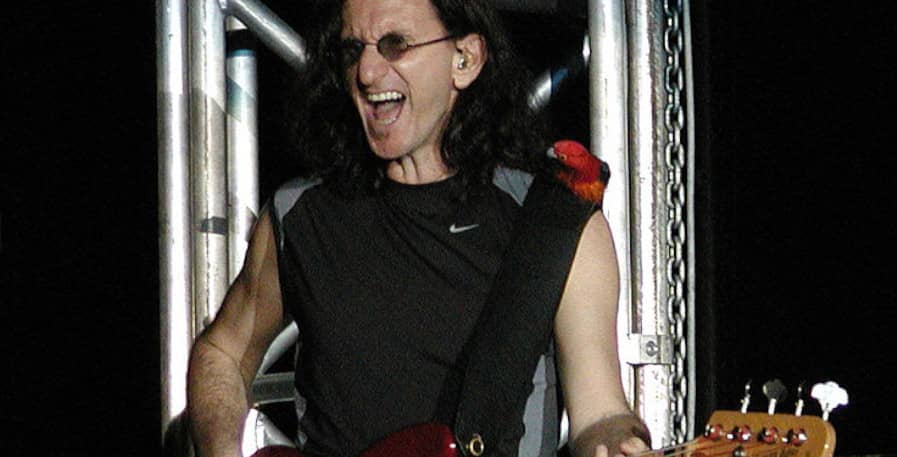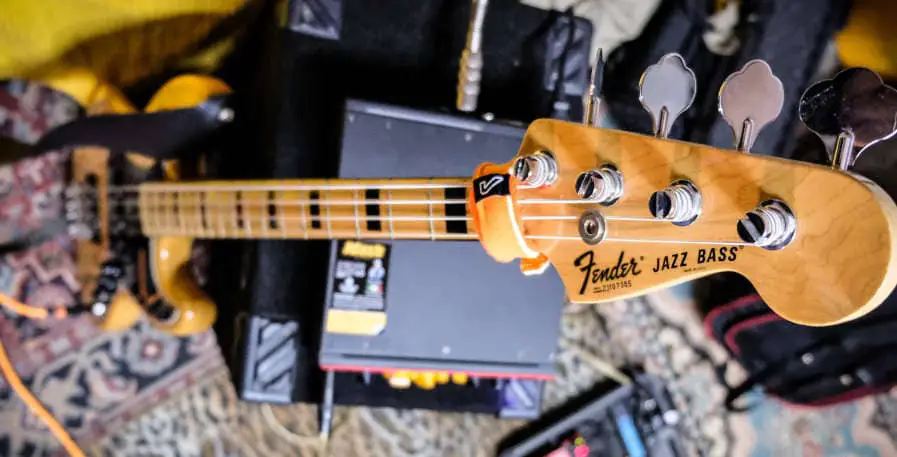This post contains affiliate links
Nowadays, Geddy Lee`s bass tone fills me with nostalgia. He was the main reason I picked up the 4-string 15 years ago, and I know he has inspired countless others.
Throughout his career, Geddy has played several different basses and his tone has changed somewhat over the years. There are also multiple core elements that make up his tone which has remained consistent for most of his career.
I will be going over what these aspects are in this article. This way, you can copy what Lee does, in order to accurately recreate his bass tone.
EQ and settings
Getting the EQ right is essential to emulate any form of bass tone. Therefore, let`s start by setting your EQ up the same way as Geddy:
High end: 7-8
The treble has to be set high in order to get the same level of brightness and clarity as Geddy. As you know, this guy likes to play a lot of melodic notes, and he plays them fast.
What happens without a bright enough tone though, is that these notes easily get lost within a band mix.
Notes will sound a lot clearer and more distinct than they would be with low treble and high bass. Thus, high treble ensures that basslines that are high in frequency and are played fast are not drowned out by the guitar.
Mid-range: 6
With high treble and low bass, it`s natural to keep the mid frequencies somewhere between them. This ensures that the tone doesn`t become too metallic or clanky.
A slightly boosted mid-range will add some brightness to compliment the high treble. It will also prevent the low end from sounding awkwardly hollow.
Low-end: 4
Geddy does not heavily rely on boosted low frequencies to fill in the low end. His aggressive plucking technique and use of overdrive ensured that Rush never sounded hollow or lacking in low frequencies.
Thus, start by turning the bass knob down to 4. Depending on your amp, you might need to turn it slightly lower. Do not be discouraged by the tone sounding too thin at this point as you will need to pluck the strings hard and add some overdrive to make this tone pop like Geddy`s.
Bridge Pickup: 90%
Geddy`s basses have mainly been active basses with at least 2 pickups. He turns the bridge pickup up for the same reason he adds the treble up: to get more brightness in his tone.
Therefore, turn this pickup close to all the way up. Depending on your bass, you might even need to turn the bridge pickup 100% up to get as close to Lee`s tone as possible.
Neck Pickup: 30%
Similarly, the neck pickup is turned down for the same reasons the low-end is dialed down. This pickup tends to have a darker and fuller sound. Lee has some of these characteristics in his tone, but not more than he needs to in order to fill in the low end.
Therefore, turn the neck pickup down to 30%, and dial it up slightly if your tone sounds overly thin.
Final settings:
Depending on your bass and amp, you might need to tweak these settings slightly. The important part is to keep the treble high and the bass low. If you steer too far from this core idea, it will become difficult to attain the same type of flanger and punch as Lee.
Therefore, as a starting point set your amp settings like this:

Setup and String Choice
Geddy Lee has used Rotosound 66 roundwound nickel strings for the majority of his career. These strings have gauges of 105-45. Lee has also utilized Rotosound Funkmasters with a lighter string gauge for parts of his career.
Due to how aggressive and bright Lee`s tone is, you want to opt for a set of strings that reflect this. This would be difficult to attain with a set of strings that sounds too dark, or too smooth.
The best choice, of course, is to use the same strings that Geddy uses himself. For most of his career, he has used this set of Rotosound 66s.
“I’ve used these strings for my entire career. So all you bass players out there, if you use them, right on, and if you don’t use them you should consider them because they’re an amazing string”
Geddy on rotosound 66`s – Guitar interactive magaize
Using a fresh set of strings will further help you bring out Lee`s signature sound. His tone relies heavily on being punchy and bright, which are characteristics that strings will lose as they get worn out. As a result, Lee himself changes his strings between every gig.
This does not mean that you have to buy a new set of 66s every time your gonna play. You should, however, regularly rejuvenate and reuse the bass strings so that your sound remains fresh.
Geddy also prefers having low action on his bass. This means that the space between the strings and frets is as small as possible. Low actions allow him to quickly fret his strings which makes it possible for him to play fast basslines with clarity.

Playing Technique
Geddy`s fingerstyle technique is not only technically proficient, but it is also a core element of his sound.
Here are the key elements of Lee`s plucking technique that make it sound distinct:
1. Aggressive plucking
Geddy is known for plucking the strings on his bass incredibly hard. This gives him a more punchy and aggressive tone. For a 3-piece band like Rush, this also helps a lot in preventing the band from sounding too hollow.
To emulate the plucking technique, practice plucking your strings harder and harder without tensing your fingers. Aim to maintain your control and technique, and gradually increase plucking strength, rather than just plucking as hard as you can.
This will take time, and will increase your chance of developing calluses. It is however a necessity to emulate his plucking to accurately emulate Geddy`s tone.
2. Plucking with the nail
Lee commonly uses the edge of his nails to pluck the strings. In his own words, this gives his tone a lot more “twang”.
“I play with my nails quite a bit, so I can get a lot of twang when I need to.. I use the edge of my nail.”
Geddy lee – 2015 interview with fender
You don`t need too much length on your nails to emulate this, but enough so that they are visible when looking at the back of your hand. If the nails are much longer than that they become prone to breaking when you play.
As for plucking with your nail, you need to be more precise than when plucking with your fingers or a pick. I recommend practicing precision at first and trying to just pluck the strings with the tip of your nail. Then, as you develop some control start adding force to your plucking as well.
3. Using one finger
Playing the bass with one finger is a staple of Geddy`s style. The inspiration behind this was the speed that pick players could reach due to doing both up and down strokes.
While bassists often do upstrokes with 2 fingers, Lee uses 1 finger to do both up and down strokes. In my experience, 1 finger is harder to control than 2, but I have also reached much higher speeds with just 1 after some practice.
If you are used to playing bass with a pick, or with 2 or 3 fingers, it will take time to develop a controlled 1-finger style. I recommend short but regular practice sessions as just using your index finger will take a toll on your stamina.
Below is a clip from an interview Lee did with Fender. In the clip, he explains the origins of his playing technique. He also gives a couple of short demonstrations of how he applies some of the key techniques explained above:
Geddy Lee`s Preamp
For most of his career, Geddy used a Tech21 Sansamp. There are several variations of this preamp on the market, which will all help you recreate Geddy`s sound.
But what`s better, is that in 2017 Tech21 partnered with Lee to create several different signature Geddy Lee preamp. These preamps are based on the classic Tech21 Sansamp, but it`s tailored towards Geddy`s own tonal preferences.
“A ‘deep clean’ tone coupled with an ‘edgy crunch’ I get from the SansAmp RPM now all in one box.”
Geddy Lee – Tech21
The YYZ model of the preamp features a 3-band EQ (lows, mids, highs) as well as a drive and mix control knob. At 10″ x 7,” it is designed to be easily portable.
The GED-2112 model is a bigger preamp, with more tonal options than the YYZ. Among other things, it features more EQ and blend options. It also allows you to adjust saturation. At 19″ x 17,” the 2112 is a great option if you`re not concerned about portability and you want more options for setting your tone.
In the clip below Geddy explains why he prefers this preamp. He also goes into detail about how to adjust the preamp to get the type of sound he wants:
A regular Tech21 Sansamp will help you emulate Geddy`s sound. However, if you don`t have one laying around, and are looking to specifically sound like Geddy, I highly recommend both these preamps.
They are products that Geddy has helped design so that he himself can sound the way he wants. Thus, it is also the perfect preamp for anyone looking to get the same type of signature sound Geddy is known for.

Bass Guitar Choice
What bass guitar you use will play a part in how much you can ultimately emulate Geddy`s tone. The most fitting choice is the same bass that Lee himself eventually gravitated towards, The Fender Jazz Bass.
This is the bass that Lee used for the majority of his career. There are multiple models of this bass, and Geddy even has a signature model. However, any type of Fender Jazz will work for getting the same type of tone as Lee.
If you don`t have a Fender Jazz, don`t worry. You will still be able to get close to Geddy`s tone with most active basses. Passive basses will struggle a bit more, as his tone relies a bit on having a bridge and a neck pickup.
As for other alternatives, Lee used a Rickenbacker 4001 from 1974 to 1983. If you are specifically looking for the type of live sound Rush had during this time period, this bass could be a fitting choice.
Lee also used a Steinberger L2 from 1982 to 1986 and used it in the recording of Grace Under Pressure. This bass has more of a niche sound that is specific to this era. If you are looking to specifically sound like Geddy did on Grace Under Pressure though, this headless bass is the instrument to go for.
Conclusion
Geddy Lee`s bass tone strikes a unique balance between powerful, quirky, melodic, and heavy. While a unique style like his will always be disliked by some, it has also propelled him to the top of multiple best bassists of all time rankings.
Recreating Geddy`s tone is a process with multiple steps, some of which are easier than others. I recommend starting with the EQ, pickup, and preamp settings. Then, get yourself a fresh set of Rotosound strings and set your action as low as possible.
Then comes the hard part. Now it`s time to practice the techniques that make Lee`s technique unique, fast and punchy. Playing aggressively with your nails and strumming with one finger will take some time to get used to it. It took me longer than I`d like to admit, but I got there. Eventually.
Once you start getting the hang of plucking the strings this way, you are in for one of the most satisfying feelings ever. This will be especially true if you have done everything else right, as you will suddenly find yourself sounding just like one of the best bass players of all time.
Geddy Lee gets a lot of credit for being able to sing while playing hard basslines. But how is this different from singing while playing the piano or the guitar? I answer this in my article on why it`s hard to sing and play bass.

